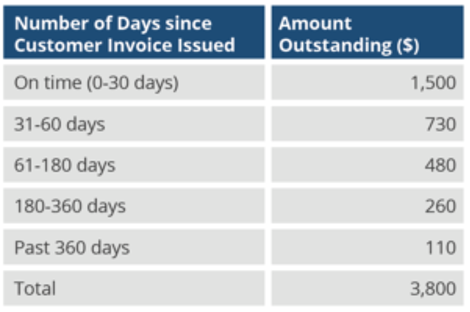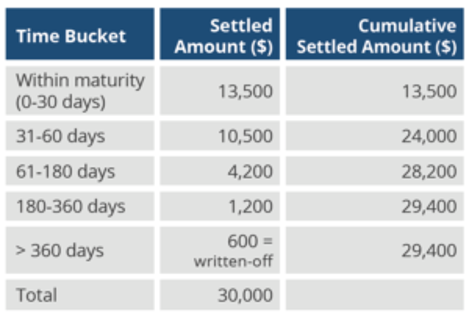11th Sep 2022, By Ernest Louw
Trade Receivables: Calculating ECL under IFRS 9
The IFRS 9 accounting standard on Financial Instruments introduced in 2018 included several changes to the accounting treatment of impaired assets. Due to the COVID-19 impact on the economy, many companies are reviewing their impairment methodologies. In light of this, we offer a short refresher on the measurement of Expected Credit Losses (ECL) with respect to Trade Receivables and Contract Assets. We will also examine how this impacts the reporting of these financial instruments.
Understanding IFRS 9 – Expected Credit Losses
One of the key differences between the previous IAS 39 standard and IFRS 9 regarding impairments is that there is no requirement that a loss event need occur before an impairment loss is recognized. This means that all assets within the scope of IFRS 9 will typically have a loss allowance, even if there is no evidence of impairment. For Trade Receivables, this means that even current receivables i.e., those not yet due, will have a loss allowance.
Under IFRS 9, a three-stage impairment model has been implemented where all financial instruments are classified into one of three stages depending on whether there has been a significant increase in the credit risk of an instrument since its initial recognition.
The stage determines how impairments are calculated and how revenue from these instruments is recognized.
At the origination of the financial instrument, the entity needs to recognise an allowance for expected credit losses arising from default events that could occur within 12 months following the reporting date (12-month ECL).
At each subsequent reporting date, the entity needs to assess whether there has been a significant increase in credit risk since initial recognition.
Stage allocation: If there has been no significant increase in credit risk then the instrument is classified as Stage 1 and the loss allowance is again measured as a 12-month ECL. If there has been a significant increase in credit risk, then the instrument is classified as Stage 2 and the loss allowance is now measured as a Lifetime ECL (expected credit losses arising from default events that could occur throughout the remaining lifetime of the asset). If credit risk increases substantially and the instrument is considered impaired, then the instrument is classified as Stage 3 with the loss allowance also measured as Lifetime ECL.
Simplified Approach for Trade Receivables
Since it is rather a subjective and complicated process to determine whether there has been a significant increase in credit risk where trade receivables are concerned, IFRS 9 allows a simplified approach whereby ECL is always measured over the lifetime of the receivable.
This means that no staging assessment is required. This simplified approach is required where the trade receivable does not have a significant financing component. If receivables do have a significant financing component then the company can select whether to use the general or the simplified approach.
The standard also allows the use of practical expedients in calculating lifetime ECL. One common practical expedient is the use of a provision matrix. Below is an example illustrating the use of a provision matrix:
Consider the below aging structure of an entity’s trade receivables at year-end for which we wish to determine the ECL. Their policy allows up to 30 days for payment of goods (i.e. there is no significant financing portion).

The entity has decided to implement the simplified approach and hence calculate the lifetime ECL to determine the impairment loss. A provision matrix will be used as a practical expedient.
Historical data
1)Define a period of sales of credit to use in the analysis and identify the portion of sales historically written-off as a credit loss, i.e. bad debt. Note that the time period should be sufficient to allow for reasonable conclusions to be made from the data, whilst also not being too long a period in case of market conditions changing and the sample set no longer being applicable.
Using a sampling period of one year’s sales records from the previous year, for the entity in our example, total sales generated came to $30,000 and the amount found to be unpaid and therefore written off as a credit loss was $600.
2)Using appropriate time buckets, create an aging payment profile of the debtors as per sample. These time buckets will usually describe the number of days since an invoice has been issued to a customer, i.e., sales credit. For our example, we split the credit sales data according to the below ages:

3) Calculate the historic default loss percentage for each time bucket, by dividing the amount outstanding at the beginning of each time period by the credit loss on all sales:
Default Rate %= Credit Loss ÷Amount Outstanding
Looking at the 61-180 days time bucket, for example, we have an amount outstanding of $6,000 = $30,000 – $24,000.
The historical default rate for this period is calculated by:
$600 (credit loss)/ $6,000 (amount outstanding at beginning of period) = 10.0%
Incorporating forward-looking information
Calculate the forward-looking loss rates by adjusting those determined from Step (3). This is the most subjective part of the process as this incorporates assumptions to be made with respect to changes in other factors such as:
- Macroeconomic (e.g. inflation, GDP, employment, interest rates)
- Regulatory, policies
- Technology
For simplicity’s sake, we will look at unemployment rates as a macroeconomic factor affecting loss rates. Here, we will assume there is a directly linear relationship between unemployment rates and the entity’s credit losses.

Say, for example, that unemployment rates are expected to increase by 1% over the next year and as a result we expect the credit loss amount will increase by 10% to $ 660. Our new forward-looking default rate for the 61-180 days bucket will be:
Now, we apply this adjusted rate to the balances in that time bucket as at the measurement date in order to determine the impairment provision/expected loss:

The same methodology would be applied across every age band as determined in Step 2 so that the total ECL will be calculated for the year in question.
You can download the dedicated white paper here.
Because determining expected credit losses can be challenging, at Lux we can help. Contact us today and learn more about our process.
Abu Dhabi
ernest.louw@luxactuaries.comSaudi Arabia
shivash@luxactuaries.comGreece
vasilis@luxactuaries.comEast Africa
joseph.birundu@luxactuaries.comNorth Africa - Egypt
ahmed.nagy@luxactuaries.comNorth Africa - Francophone
mohammed.moussaif@luxactuaries.comSouthern Africa
siobhain.omahony@luxactuaries.comWest Africa
andrew.slater@luxactuaries.comSubscribe to our newsletter
To receive your quarterly updates.
By completing this form you are opting into emails from Lux Actuaries. You can unsubscribe at any time.
© 2026 All rights reserved.


